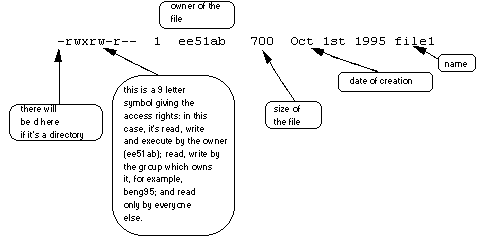
In your unixstuff directory, type
% ls -l (l for long listing!)
You will see that you now get lots of details about the contents of your directory, similar to the example below.

Each file (and directory) has associated access rights, which may be found by typing ls -l. Also, ls -lg gives additional information as to which group owns the file (beng95 in the following example):
-rwxrw-r-- 1 ee51ab beng95 2450 Sept29 11:52 file1
In the left-hand column is a 10 symbol string consisting of the symbols d, r, w, x, -, and, occasionally, s or S. If d is present, it will be at the left hand end of the string, and indicates a directory: otherwise - will be the starting symbol of the string.
The 9 remaining symbols indicate the permissions, or access rights, and are taken as three groups of 3.
The symbols r, w, etc., have slightly different meanings depending on whether they refer to a simple file or to a directory.
So, in order to read a file, you must have execute permission on the directory containing that file, and hence on any directory containing that directory as a subdirectory, and so on, up the tree.
| -rwxrwxrwx | a file that everyone can read, write and execute (and delete). |
| -rw------- | a file that only the owner can read and write - no-one else can read or write and no-one has execution rights (e.g. your mailbox file). |
Only the owner of a file can use chmod to change the permissions of a file. The options of chmod are as follows
| Symbol | Meaning |
|---|---|
u |
user |
g |
group |
o |
other |
a |
all |
r |
read |
w |
write (and delete) |
x |
execute (and access directory) |
+ |
add permission |
- |
take away permission |
For example, to remove read write and execute permissions on the file biglist for the group and others, type
% chmod go-rwx biglist
This will leave the other permissions unaffected.
To give read and write permissions on the file biglist to all,
% chmod a+rw biglist
Try changing access permissions on the file science.txt and on the directory backups
Use ls -l to check that the permissions have changed.
A process is an executing program identified by a unique PID (process identifier). To see information about your processes, with their associated PID and status, type
% ps
A process may be in the foreground, in the background, or be suspended. In general the shell does not return the UNIX prompt until the current process has finished executing.
Some processes take a long time to run and hold up the terminal. Backgrounding a long process has the effect that the UNIX prompt is returned immediately, and other tasks can be carried out while the original process continues executing.
To background a process, type an & at the end of the command line. For example, the command sleep waits a given number of seconds before continuing. Type
% sleep 10
This will wait 10 seconds before returning the command prompt %. Until the command prompt is returned, you can do nothing except wait.
To run sleep in the background, type
% sleep 10 &
[1] 6259
The & runs the job in the background and returns the prompt straight away, allowing you do run other programs while waiting for that one to finish.
The first line in the above example is typed in by the user; the next line, indicating job number and PID, is returned by the machine. The user is be notified of a job number (numbered from 1) enclosed in square brackets, together with a PID and is notified when a background process is finished. Backgrounding is useful for jobs which will take a long time to complete.
It is sometimes necessary to kill a process (for example, when an executing program is in an infinite loop)
To kill a job running in the foreground, type ^C (control c). For example, run
% sleep 100
^C
Alternatively, processes can be killed by finding their process numbers (PIDs) and using kill PID_number
% sleep 100 &
% ps
PID TT S TIME COMMAND
20077 pts/5 S 0:05 sleep 100
21563 pts/5 T 0:00 netscape
21873 pts/5 S 0:25 nedit
To kill off the process sleep 100, type
% kill 20077
and then type ps again to see if it has been removed from the list.
If a process refuses to be killed, uses the -9 option, i.e. type
% kill -9 20077
Note: It is not possible to kill off other users' processes !!!
ls -lag |
list access rights for all files |
chmod [options] file |
change access rights for named file |
command & |
run command in background |
^C |
kill the job running in the foreground |
kill %1 |
kill job number 1 |
ps |
list current processes |
kill 26152 |
kill process number 26152 |
Originally created by M.Stonebank@surrey.ac.uk edited to be used with Cygwin, 9th October 2000